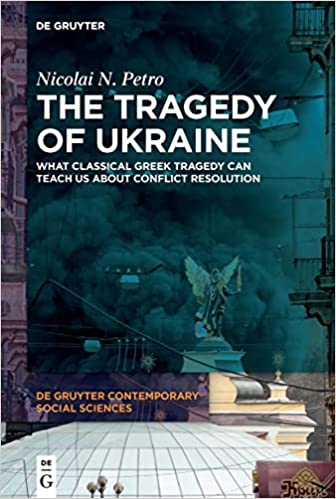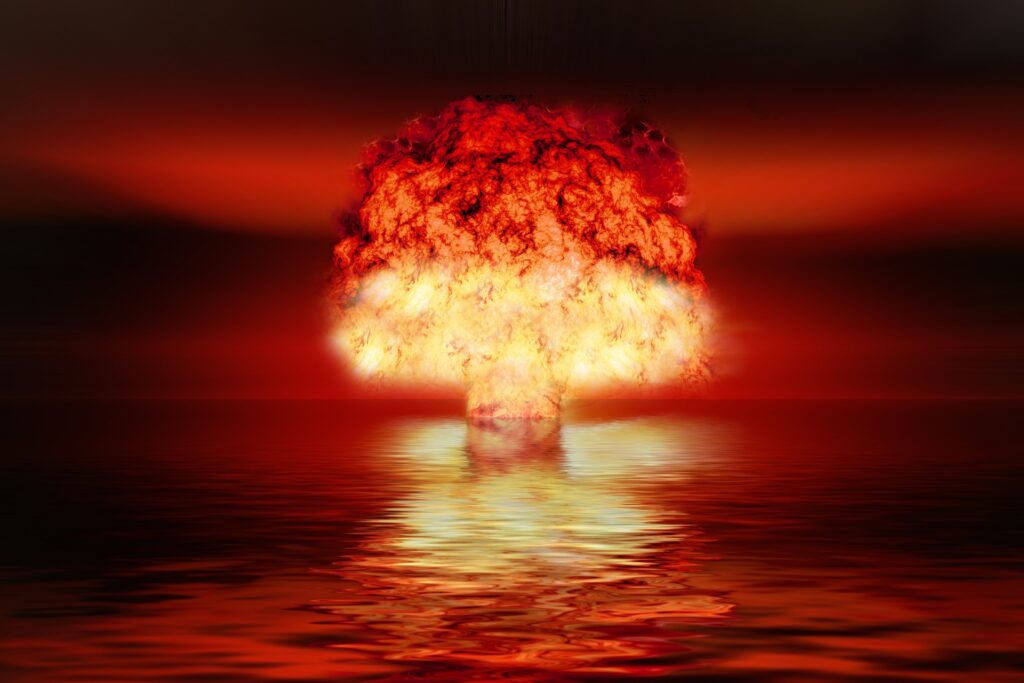
There are several academics whose work on Russia and the former Soviet Union I have found to be excellent and reliable. These include the late Stephen F. Cohen, Richard Sakwa, Paul Robinson, Dominic Lieven, and Nicolai Petro (among a few others). I had been looking forward to reading Petro’s latest work, The Tragedy of Ukraine, which couldn’t be more timely.
Petro dives into the complex history of Ukraine and its relationship to imperial Russia, the Soviet Union and contemporary Russia. He emphasizes the point that, unfortunately, has to be repeated constantly in the west that this conflict did not begin on February 24, 2022. As Petro writes:
“[T}he current conflict is merely the latest in a series of conflicts that have bedeviled this area of the world for more than a century. These include: the great power rivalry between Russia and the West; the conflict between Russia and Ukraine; and finally, the conflict within Ukraine itself over its national identity, its relationship to Russia, and its role in the world. It is, in sum, a conflict about who gets to define Ukrainian identity.” (p. 1)
He goes on to explain the internal divisions within the borders of post-Soviet Ukraine. In western Ukraine, the Galician influence predominates and this is predicated upon the rejection of not only Russian culture, but of virtually any active relationship with Russia, including trade. This attitude is considered by its adherents to be “decolonization” and representing the only way for Ukraine to be truly Ukrainian. It is an ideology based on exclusion and an ethnic definition of identity.
In the southeastern part of modern day Ukraine, there is what Petro calls the Maloross identity, which has close historical and cultural ties to Russia that are of major importance, though this population didn’t necessarily want to become part of the Russian state prior to the events of 2013-2014 and the subsequent civil war. According to Petro, the Maloross Ukrainian identity saw itself as distinct from but complementary to Russia and its culture. It rejected the view that Ukraine must choose between Europe and Russia, preferring instead a partnership with both. On one side, the Galician ideal was for Ukraine to serve as a bulwark of the west against Russia, while the Maloross ideal was for Ukraine to serve as a bridge between both.
This was the core of the problem after the illegal overthrow of the democratically elected government in Kiev in 2014, a government that subsequently implemented policies on behalf of a Galician ideal. The residents of the Donbas (Maloross) saw the change of government as an illegitimate coup and genuinely feared and rejected the Galician policies it began to undertake.
Petro acknowledges that Ukraine has had a rocky path as an independent country since 1991, experiencing economic decline and high inequality, despite having emerged from the Soviet era as one of the most developed and resource-rich republics of the USSR*. Moreover, there are region-dependent differences in terms of economics in the country (e.g. industrial v. agricultural, etc.) This has been another factor that has contributed to the complicated divisions and instability within Ukraine.
As the conflict of 2014 has escalated over the years, the history of Ukraine has become weaponized by both sides to varying degrees:
“At its heart this is a debate about power – the power to define Ukrainian identity. In this power struggle both sides appeal to history, which since 2014 has become a minefield that must be navigated very carefully. The issue of whether to interpret a millennia of common history with Russia – as a colonial imposition to be rejected, or an imperial heritage to be proud of – has often been used to keep the conflict between these two competing Ukrainian national identities burning.” (p. 38)
Ukraine, along with Russia, constituted a “loose federation of East Slavic tribes – warrior-traders – ruled by the Rurik dynasty from 9th to 13th century”. Ties were buttressed by a shared Orthodox religion due to Prince Vladimir choosing that religion for people of the Kieven Rus area in the 10th century. By the time of the Mongol invasion of the 13th century, the area had degenerated into rivalries among various princes who’d lorded over a dozen or so independent areas.
The Mongol massacre killed about 2/3 of the population. Some of the survivors managed to flee closer to what is modern-day Moscow and those who remained were forced into subjugation. Slavic bonds were ruptured by the Mongol takeover. Those from the southern part of the Kieven Rus region later became known as Ukrainians and were cut off and later ruled over by Poles and Lithuanians .
In the mid-17th century (1654), the Pereyaslavl Treaty united Ukraine to Russia as an autonomous region and in turn led to a 13-year war between Russia and Poland which resulted in the division of Ukraine between Poland and Russia (Britannica). From then on, the Ukrainian-speaking parts of Poland-Lithuania were progressively conquered by the Russian Empire, leading many Orthodox Ukrainians to strongly identify with Russia . From the late 18th century on, Russians referred to Ukraine territory as Malorussia or “Little Russia” viewing Ukraine and the Ukrainian language as having emanated from the greater Russian history and culture and later sought to standardize it to Russian.
The Western parts of modern-day Ukraine were part of the Austro-Hungarian Empire in the 19th and early 20th centuries while the southeastern portion was part of the Russian Empire. An independent Ukrainian state emerged very briefly in the years of the Russian Revolution and early civil war period, but the project failed in 1919. From then until WWII, parts of Ukraine were ruled by Poland, Romania, Czechoslovakia, and Soviet Russia – the latter becoming a Soviet Republic ruled by the Communist Party. Russian/Soviet rule of Ukraine in the 19th and 20th centuries created complex patterns of migration with significant parts of southern Ukraine settled by Russians, including those who came to work in the mines and factories of the Donbas region, bringing the Russian language with them.**
Petro points out that many contemporary Russians view the Russians (Great Russians in the north), Ukrainians (Little Russians in the south), and Belarusians (White Russians in the west) as one people as promulgated by the writings of Innocent who was the 17th century Abbott of the Kieven Orthodox Monastery. Innocent’s assertion was based on territorial unity, religious (Orthodox faith) and linguistic/literary unity throughout these areas, and the governing princes of all territories having descended from the Ryurik line.
An alternative historical view – the western Ukrainian/Galician view – was put forth by an academic named Mikhail Grushevsky (1866-1934) who taught at the University of Kiev and asserted that “Ukraina-Rus” emerged on the territory of modern-day Ukraine much earlier and had descended from the ancient steppe culture of Scythia leading to “divergent patterns of development in Ukraine and Russia’ which included “a distinct line of statehood for Kievan Rus that in the Principality of Galicia-Volhynia, and later in the Zaporozhian Sich, before it was finally incorporated into the Russian Empire by Catherine the Great.” (p. 39)
Ukrainian nationalists do not think Rus should equate with Russia but that Russia should be referred to as Muscovy and that Moscow did not emerge as the new center of a common people from Kiev due to the Mongol destruction of Kiev in the 13th century, but as a “poisonous” phenomena that kept Kiev from its proper glory.
This conflict, given its historical and ideological roots as well as its brutality, would appear to be implacable. But, here, Petro provides a possible means of avoiding a never-ending cycle of hatred and revenge once the sides cease actual physical fighting. Essentially, Petro thinks a truth and reconciliation commission should be put in place. He provides examples of successful but somewhat different models of such commissions in South Africa, Spain and Guatemala.
But another argument offered for this solution goes much further back – the role of the Greek tragedy, which – contrary to what many may believe – played a far more crucial role in Greek life than merely as a source of entertainment. He explains that Greek tragedy focused on the human emotions that play an important role in intractable conflicts that cause suffering and that the exploration and acting out of tragedy fostered understanding, compassion and healing among the different sides to a conflict, thus seeking to break the cycle of hatred and vengeance.
The tragedies acted out in Athens deliberately took on controversial topics, provided moral guidance, and taught its audience how to be better citizens, with the idea that qualities like moderation and prudence were skills that could be taught to everyone. Themes addressed included the negative consequences of hubris, arrogance, and inequality. The danger of self-righteousness, the problem of creating a larger moral wrong when attempting to correct a perceived existing moral wrong, was recognized. According to Petro: “tragedy trained citizens to recognize and avoid policies that could lead to disaster.” (p. 10)
Petro uses the Greek tragedy playwright Aeschylus as an example:
“Aeschylus wants the audience to see that creating a harmonious social order requires former enemies to become stakeholders in society.” (p. 30); He explains that the process involves: 1) raising awareness that the effort of reconciliation will require all of society to effectuate, 2) catharsis or purging, and 3) dialogue. This will lead to genuine justice rather than the continuing cycle of revenge.
Petro also states that Ukraine, in order to attain long-term stability, must eventually base its sense of identity and loyalty on civic patriotism rather than ethnicity, religion or culture:
“While nationalism values above all else cultural, religious, and ethnic unity, patriotism values above all else the people’s common liberty, which is enshrined in the republican ideal of equality before the law.” (p. 131)
If you’re looking for a thought-provoking book that explains the complex history of Ukraine, its relationship to Russia, and the underlying causes of the current conflict, I highly recommend this one.
*An excellent book that delves into this specific aspect of post-Soviet Ukraine can be found here and more about it will be discussed at this blog in the future.
**This historical summary is taken not just from information in Petro’s book, but also Richard Sakwa’s Frontline Ukraine and Anatol Lieven’s “Ukraine Should be a Bridge, Not a Battleground.“


